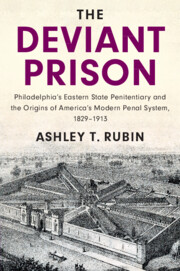 The Deviant Prison
The Deviant Prison from Part I - Becoming the Deviant Prison: Establishing The Conditions for Personal Institutionalization
Published online by Cambridge University Press: 12 January 2021
America's early prisons—first the proto-prisons built after the American Revolution and the modern prisons built in the 1820s and later—failed repeatedly and dramatically. These failures and the debates they precipitated gave modern prisons a perennial air of uncertainty. Would they solve the problems endemic to the proto-prisons—and serve the prison's original purpose?Moreover, news of penal failures like Auburn often had sudden and unpredictable impacts on the penal imagination and what commentators believed to be acceptable design choices for the new prisons. In the resulting atmosphere, deviations from the norm seemed even more risky and penal actors routinely sought assurance that they were on the right path. Thus, it is only by understanding this tumultuous, unstable beginning—when reformers repeatedly experimented with variations of prison and failed—that we can begin to understand how Eastern became a deviant prison and how the Pennsylvania System could become personally institutionalized at Eastern in the decades to follow.
To save this book to your Kindle, first ensure [email protected] is added to your Approved Personal Document E-mail List under your Personal Document Settings on the Manage Your Content and Devices page of your Amazon account. Then enter the ‘name’ part of your Kindle email address below. Find out more about saving to your Kindle.
Note you can select to save to either the @free.kindle.com or @kindle.com variations. ‘@free.kindle.com’ emails are free but can only be saved to your device when it is connected to wi-fi. ‘@kindle.com’ emails can be delivered even when you are not connected to wi-fi, but note that service fees apply.
Find out more about the Kindle Personal Document Service.
To save content items to your account, please confirm that you agree to abide by our usage policies. If this is the first time you use this feature, you will be asked to authorise Cambridge Core to connect with your account. Find out more about saving content to Dropbox.
To save content items to your account, please confirm that you agree to abide by our usage policies. If this is the first time you use this feature, you will be asked to authorise Cambridge Core to connect with your account. Find out more about saving content to Google Drive.